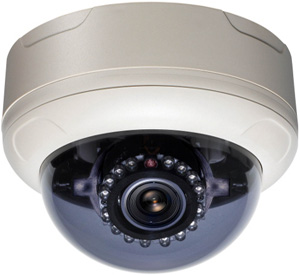 The development of the dome camera is a relatively recent one when compared to the total history of camera surveillance equipment. Advances in technology made it possible to use smaller components while still constructing cameras just as good, if not better than many of their fixed counterparts.
The development of the dome camera is a relatively recent one when compared to the total history of camera surveillance equipment. Advances in technology made it possible to use smaller components while still constructing cameras just as good, if not better than many of their fixed counterparts.
If you need a complete pan, tilt and zoom (PTZ) style camera, it is hard to beat the compact design of dome cameras. One of the best things about dome cameras is that all functionality is contained within the dome housing hardware.
You do not need a big motor and added energy it takes to make a larger camera pan over a secured area. You also don’t need to clear a lot of space because of the unit’s relatively small size.
Pan, Tilt and Zoom Described
One of the first things to look at when evaluating PTZ cameras is the pan capability or the ability of the camera to rotate on an axis perpindicular to the ground. Many cameras today have a 360° pan range, meaning the camera can rotate in a continuous circle, so this setting is less of a concern.
The other important pan setting is the pan speed. The best PTZ cameras can pan 360° in one second. Speed is important, because if the camera pans too slowly, it’s too easy for the ‘bad guys’ to circumvent. Any proposed PTZ installation should be setup in such a way that the camera provides thorough coverage and does not leave any part of a secured area out of view long enough to allow a security breach.
The tilt capability of a camera refers to its rotational motion on an axis parallel to the ground. The combination of pan and tilt allow dome cameras to function much like a universal joint does. A good PTZ camera will have the ability to be preset to cover more than 100 locations. This allows the camera to not only cover a wide range of positions, but to also avoid wasting time covering areas that do not need coverage or are less critical.
The zoom feature is a dome camera’s capability to enlarge the image as though it were being viewed from an increasingly closer distance to the subject being filmed. When the image is not enlarged or shrunk, the zoom level is at 1X. If an object being filmed is 20 feet away, but appears to be five feet away, the zoom level is 4X. The zoom setting has a tradeoff between how large an area you want to cover versus how close a view you want to have of what you are filming. If you zoom in too far, you get better detail of what the camera is looking at, but at the expense of reduced area coverage.
Other Considerations of PTZ Cameras
There are other important considerations when buying a PTZ camera. Will it be used indoors or outdoors? If so, then the camera housing should keep moisture out and be rated for operation in extreme temperatures. Do I need an infrared camera for night time surveillance or not? Does the camera need to be protected against vandalism or not? Since dome cameras with PTZ are very expensive, good budgeting dictates that you avoid features you don’t really need. You may also find it less expensive to use multiple fixed dome cameras instead as it is possible to get several fixed models for the price of one PTZ model.
Conclusion
Although among the more expensive surveillance cameras, PTZ dome camera options offer greater coverage and flexibility that fixed models simply can’t. It is important however, to be careful about buying features that you don’t need, since the cost of these cameras can escalate quickly as you get more features. In many cases, it my prove better and more economical to use a combination of fixed cameras. As with any surveillance system, knowledge is the best friend a buyer can have. This means careful analysis and planning before going out and spending money.
About the author: Erik Johnson is a seasoned veteran of the CCTV Surveillance industry. He shares his knowledge with home owners and business owners so they can take the vital steps in better securing their most valuable assets. A security camera system is the best way to secure the things that are most important to you!